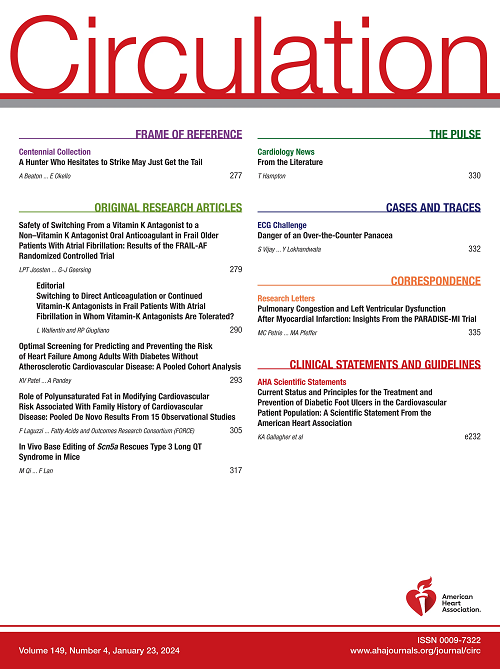Pulsed Field Ablation of Persistent Atrial Fibrillation With Continuous ECG Monitoring Follow-Up: ADVANTAGE AF-Phase 2.
IF 35.5
1区 医学
Q1 CARDIAC & CARDIOVASCULAR SYSTEMS
引用次数: 0
Abstract
BACKGROUND There is sparse high-quality safety and effectiveness data for pulsed field ablation (PFA) of persistent atrial fibrillation (PerAF), where lesions beyond pulmonary vein isolation (PVI) are often placed. Additionally, no large trials have used insertable cardiac monitors (ICMs) for continuous rhythm monitoring post-ablation in PerAF patients, or after PFA in any AF population. In ADVANTAGE AF-Phase 2, PerAF patients underwent PFA for PVI and posterior wall ablation (PWA), and in a sub-cohort, cavotricuspid isthmus (CTI) ablation for typical atrial flutter. METHODS PerAF pts underwent PVI and PWA with the pentaspline PFA catheter, and CTI with a novel focal-linear PFA catheter after IV NTG prophylaxis. Patients were followed for 1 year with continuous rhythm monitoring after ablation with ICMs to 1) emulate traditional intermittent monitoring for the primary efficacy endpoint, and 2) examine atrial arrhythmia (AA) burden and episode duration. RESULTS This 255-patient cohort (age 66.7±9.3, female 29%, CHA2DS2-VASc 2.4±1.4, BMI 30.9±5.3, left atrium diameter 4.3±0.6 cm) underwent PVI plus PWA (99.6%/100% acute success); a subpopulation (n=141; 55.3%) also received CTI PFA, with 98.6% achieving bidirectional block without complications (ST changes, ventricular fibrillation). CTI ablation took 8±13 minutes, using 18±6 PF applications and 4±2 mg IV NTG. The total procedure and atrial dwell times were 105±36 and 59±24 minutes, respectively. Mimicking traditional monitoring, freedom from AA was 73.4% with adverse events in 2.4%, both meeting prespecified endpoint criteria. Freedom from recurrent atrial flutter was 97.2%. Detailed analysis of the full ICM data revealed freedom from AA ≥30 seconds in 52.0%, and no episode exceeded 24 hours in 94.0% of this PerAF cohort. An AA burden >0.1% or longest episode duration >1 hour were both predictive of increased healthcare utilization. One-year procedural effectiveness was 71.6% and 70.0% using these ≤0.1% burden and <1 hour duration thresholds, respectively. CONCLUSIONS In ADVANTAGE AF-Phase 2, the first multicenter PerAF study of PFA with continuous rhythm monitoring: i) CTI ablation with NTG prophylaxis was safe and effective, ii) PVI + PWA was safe and effective, and iii) an AA burden <0.1% and AA episode <1 hour duration were endpoints associated with the lowest healthcare utilization.求助全文
约1分钟内获得全文
求助全文
来源期刊

Circulation
医学-外周血管病
CiteScore
45.70
自引率
2.10%
发文量
1473
审稿时长
2 months
期刊介绍:
Circulation is a platform that publishes a diverse range of content related to cardiovascular health and disease. This includes original research manuscripts, review articles, and other contributions spanning observational studies, clinical trials, epidemiology, health services, outcomes studies, and advancements in basic and translational research. The journal serves as a vital resource for professionals and researchers in the field of cardiovascular health, providing a comprehensive platform for disseminating knowledge and fostering advancements in the understanding and management of cardiovascular issues.
 求助内容:
求助内容: 应助结果提醒方式:
应助结果提醒方式:


